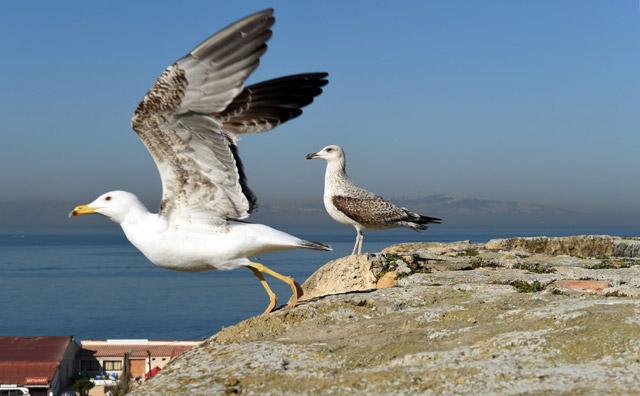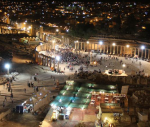You are here
Invading 'rat of the sky' irks Algerians
By AFP - Apr 13,2017 - Last updated at Apr 13,2017

A Yellow-legged Gull takes flight as another perches on a cliff near the Tamentfoust harbour, east of the capital Algiers, on March 19 (AFP photo)
ALGIERS — "It's not a bird, it's a rat — and it's squatting on my terrace," Ali says of his new neighbour, a yellow-legged gull — a pest ubiquitous in the Algerian capital.
The 60-year-old is not alone in despising this versatile scavenger, whose Mediterranean population has boomed in recent decades.
The "rat of the sky" has taken advantage of human waste to supplement its normal marine diet, breeding fast and becoming the region's most common seabird.
Aicha, an Algiers resident with henna-dyed hair, has shared her home with a pair of gulls and their offspring for three years.
"They eat all the leftovers," she says. "No need for a bin."
Nawel Derradji, a doctoral student in animal ecology at the University of Bab Ezzouar in Algiers, says the country's open-air rubbish tips have given the gulls "abundant, readily accessible and regularly renewed sources of food".
That has driven "an extension of its breeding range and its colonisation of new habitats, in particular urban areas", she adds.
The yellow-legged gull, only recently classified as a species distinct from the herring gull, is invasive, aggressive, noisy and very messy.
Today the birds can be found as far as 100 kilometres inland, says Professor Riadh Moulai of the University of Bejaia.
'Cliffside' high-rise nests
"In the last 25 years, the population growth of yellow-legged gulls has doubled, and in some places it has reached 400 per cent," he says, saying that cutting the country's reliance on open-air rubbish tips could drastically limit the species' spread.
The gull has adapted well to the urban environment, swapping its normal cliffside dwellings for terraces on the capital's high-rise apartment blocks where it builds nests out of rags, bones and bits of plastic.
A recent study in the capital found some 150 nests, compared with just three in 2011. But as they are difficult to locate, the real figures may be much higher, Derradji says.
That poses tough problems, she says, adding that the gull preys on smaller urban birds.
But despite its poor reputation, the Yellow-legged Gull has its fans.
Rachid, a fisherman from Tamentfoust, 25 kilometres east of Algiers, has welcomed his new neighbours.
"Four couples have lived on my terrace for several years. I sometimes take them sardines in the evening," says the seaman in his sixties, his skin baked brown by the sun.
"I put down the fish and they help themselves."
Ali is not so enthusiastic. He says the "plague" of birds has almost stopped him using his terrace.
"It's not even possible to hang out the washing or sit down for a moment — there's too much muck. They poop everywhere," he says.
It's a shame the gulls are not edible, he adds with a wry smile.
"That would have limited their spread."
Related Articles
KUALA LUMPUR — Masks that helped save lives during the coronavirus pandemic are proving a deadly hazard for wildlife, with birds and marine
PARIS — Police fought running battles in at least five suburbs of Paris overnight with residents who accused officers of using heavy-handed
MECCA — A fire forced some 1,500 people from their hotel in the Saudi city of Mecca on Monday, as hundreds of thousands gathered for the Haj


















